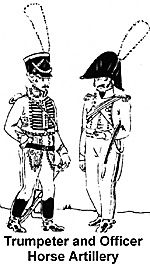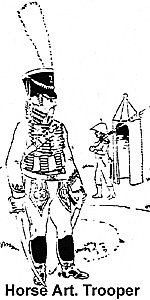 Recently, Jean Lochet gave me a copy of the famous Manuscrit du Bourgeois de Hambourg, authored by the Hamburger Doctor Christopher Suhr, well known in the world of collectors but unknown by most common folks like us. It is a very rare manuscript and, although aware of it, I never had the opportunity to examine it extensively. Our copy has only black and white plates with a description of the different colors found on the uniforms.
Recently, Jean Lochet gave me a copy of the famous Manuscrit du Bourgeois de Hambourg, authored by the Hamburger Doctor Christopher Suhr, well known in the world of collectors but unknown by most common folks like us. It is a very rare manuscript and, although aware of it, I never had the opportunity to examine it extensively. Our copy has only black and white plates with a description of the different colors found on the uniforms.
The original manuscript was published by Suhr in Hamburg, who had the exclusive privilege of reproducing the lithographs until 1816. The published copies were pen-drawn on lithographic stones and then hand-colored. The original drawings made by Suhr have since disappeared. The surviving copies of the original are very rare and one was to be found in the Hamburg Library.
Suhr's collection was drawn between 1806 and 1815 and includes no less than 37 plates covering the Spanish of the Army of Romana, 6 on the Italians, 55 on the French, 35 on the Dutch, 7 on the Westphalians, 8 on Frankfurt and Berg, 1 on Scharzburg-Rudolstadt and Saxe, 3 on the Hanoverians and 1 on Brunswick, the Hanseatic troops, and the Prussians, 3 on the Danes, 1 on the Swedes, and 7 on the Russians.
In spite of the fact that these plates were drawn quickly and could be considered somewhat primitive by our modern standards, they provide us with an invaluable source of firsthand details on the uniforms described, information otherwise unavailable.
The pertinent parts of the Manuscript for today's discussion cover the details of the Hungarian knot used by the Dutch army, information provided by two plates on the Dutch army horse artillerists (Plates 121 and 122) which offer a good idea of how the Hussar uniform looked (see article on the 11th Hussars, pp.62-66). These plates are reproduced below with a uniform description which includes the colors used. As can be seen, the Dutch horse artillerists wore a uniform very similar to that of the classic Hussars. That is not unusual as horse artillerists considered themselves a truly elite corps. What cavalry was more elite than the Hussars? In fact, so similar were the two uniforms that, by just changing the red of the facings, etc. we have the Hussar uniform, which is reproduced page 63, (and following pages) from an anonymous gouache kept at the Musée Royal de l'Armée et d'Histoire, in Brussels, Belgium.
PLATE 121:
TRUMPETER AND OFFICER OF HORSE ARTILLERY
(1) Trumpeter: Black shako; chin straps and number 2, yellow; cords, pompoms, and tresses, scarlet; top trimming of shako and plume, scarlet; white collar; dolman, scarlet; all other trimmings, tresses, etc., deep blue; yellow buttons; breeches, scarlet with lateral piping; and Hungarian knot, deep blue; belts, sabretache, black; black boots; trumpet, yellow; scarlet banner with scarlet and deep blue sash.

(2) Officer: Black hat; ganse, buttons, yellow (gold), scarlet plume; black collar piped with white; deep blue coat; collar and piping, scarlet; shoulder straps and buttons, gold; banderole, white with two black lines; medal, silver with sky-blue ribbon; waistcoat, scarlet with 3 rows of yellow buttons; red belt piped gold; blue trousers with two red stripes; black shoes; saber with black piped yellow.
PLATE 122:
HORSE ARTILLERY: TROOPER
Shako identical to that of the trumpeter; black collar piped white; dolman, deep blue; collar, deep blue with red ornaments; scarlet tresses; yellow buttons; black banderole with yellow ornaments; red belt sash with deep blue; black belt with copper buckle; breeches, deep blue with scarlet Hungarian knots and stripes; black boots; saber with steel scabbard.
In the background is a foot artillerist. Black hat with scarlet pompom; deep blue coat, scarlet collar and turnbacks, lapels piped scarlet; waistcoat and trousers of deep blue; white gaiters; brass hilt.
Back to Empire, Eagles, & Lions Table of Contents Vol. 3 No. 2
Back to EEL List of Issues
Back to MagWeb Master Magazine List
© Copyright 1997 by Jean Lochet
This article appears in MagWeb (Magazine Web) on the Internet World Wide Web.
Other military history articles and gaming articles are available at http://www.magweb.com
